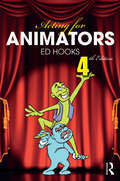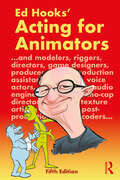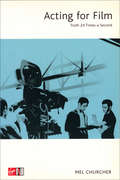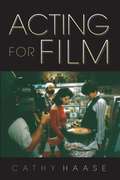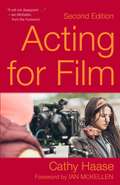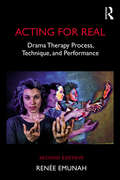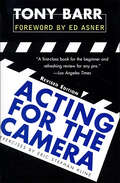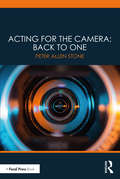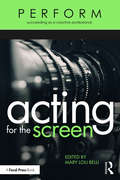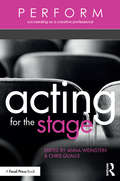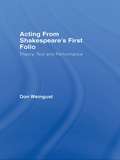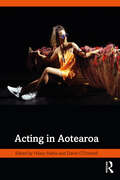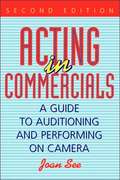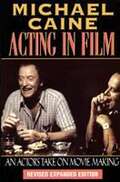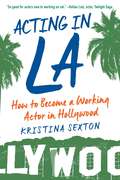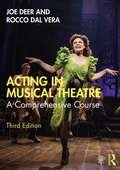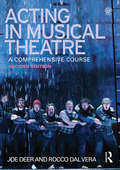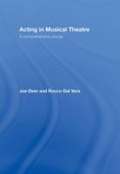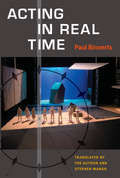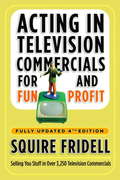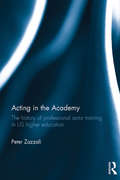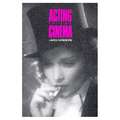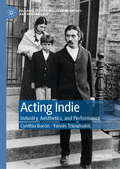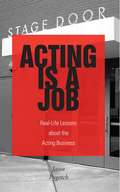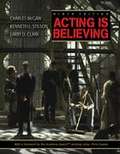- Table View
- List View
Acting for Animators: 4th Edition
by Ed HooksEd Hooks' essential acting guidebook for animators has been fully revised and updated in this 4th edition. Hooks uses classical acting theory – from Aristotle to Stanislavsky and beyond – to explain everything from character analysis and physical movement to facial expression and scene structure. He speaks directly to animators, instead of stage or screen actors. Acting for Animators is an invaluable primer for beginner animators and a useful reference for experienced pros. New to this fourth edition: - 6 new scene-by-scene acting analyses of animated feature films, including Zootopia and The Little Prince - an annotated analysis of Walt Disney’s famous 1935 memo to Don Graham, regarding how best to train animators - advice to the animator about how best to perform visual references - a chapter on Virtual Reality - an online database of Ed’s previous film analyses, all in one place.
Acting for Animators
by Ed HooksEd Hooks' essential acting guidebook for animators has been fully revised and updated in this fifth edition, capturing some of the vast changes that have affected the animation industry in recent years. Written specifically for animation professionals instead of stage and movie actors, this book provides an essential primer for creating empathetic and dynamic character performance and, in the process, shows how the strongest storytelling structure works. Hooks applies classical acting theory – from Aristotle to Stanislavsky and beyond – to animation, as well as explaining scene structure, character development and the connections between thinking, emotion and physical action. Theory presented here applies to any and all character animation regardless of style or animation technique. Whether your project is stop-motion, 2D, 3D or a blend of techniques, audiences are audiences are audiences, and they have shown up at the theater or cinema so they can experience and enjoy your story. New to this fifth edition: Four new scene-by-scene acting analyses of animated feature films: Flee, Soul, Porco Rosso and The Triplets of Belleville. A comprehensive and updated section titled "Classroom Notes" which includes a segment on experimental animation, a brief history of acting training for actors and guidance on Motion and Performance Capture technology. Updated online database of Hooks' previous film analyses, all in one place. Acting for Animators is essential reading for all students and teachers of animation courses.
Acting For Film
by Mel ChurcherThe author uses her wide experience as an acting and voice coach an major movies to offer insights into the film acting process. She provides tasks, techniques and tips that are designed specifically for film: there's advice to make the first-time film actor feel at home on set, tips on the casting process, how to cope with auditions, on-camera techniques, schedules and shooting order, as well as specific advice from film crews to help an actor's performance. This practical workbook combines exercises and anecdotes in an informal and accessible style, making it the indispensable guide for anyone wishing to light up the silver screen.
Acting for Film
by Cathy HaaseAspiring film and television actors will discover exercises for relaxing the face to achieve maximum expressiveness; maintaining proper eye focus in front of the camera and conveying the "beats" of a scene, even in the shortest takes. They'll also learn tested techniques for adapting to the styles of different directors; modulating voice and breath for maximum effect; preparing for the first day on the set; enduring multiple takes and on-the-set waiting; and much, much more. For any performer who intends to make a living in front of the camera, Acting for Film is the most authoritative resource!
Acting for Film (Second Edition)
by Cathy Haase Ian McKellen"It will not disappoint . . ." —Ian McKellen, from the ForewordAn Authoritative Training Manual for Film Actors and Teachers “In today's entertainment industry of buff bodies and beautiful faces, it's easy to think that a couple of sit-ups and high cheek bones can create a movie legend,” writes film veteran Cathy Haase. However, she adds, what the actor really must have are “technique, craft, and a depth of self-knowledge.” In Acting for Film, Second Edition, Haase shows actors how to develop all of these, sharing her secrets (developed through years of on-camera work) for creating characters who come alive and who touch the souls of the audience. Readers will learn how to apply theatrical training to film acting and hone a personal approach to rendering a character. Acting for Film, Second Edition, is an essential guide for aspiring performers, acting teachers, and anyone interested in gaining a greater understanding of the craft. This new edition includes: Advice on dealing with new technology including CGI and motion capture Concentration and relaxation exercises that will enhance facial expressiveness Exploration of sense memory techniques for on-camera work Animal exercises and their usages Tips for maintaining proper eye focus in front of the camera and conveying the “beats” of a scene, even in the shortest takes For any performer who intends to make a living in front of the camera, Acting for Film, Second Edition, is the most authoritative resource! With Haase’s experience and advice in their pocket, readers will be prepared to land the film role they’ve been dreaming of.
Acting For Real: Drama Therapy Process, Technique, And Performance
by Renée EmunahThis second edition takes the reader further into the heart of using drama for healing. Dr. Emunah offers an expanded understanding of her Integrative Five Phase model, a foundational approach that embraces the wide spectrum of possibilities within the playing field of drama therapy. Grounded by compassionate clinical examples, including ones that reach over time into deep-seated issues, the book offers tools for action-oriented treatment, embodied therapeutic interventions, and creatively engaging a wide variety of clients. This comprehensive text also contains over 120 techniques, categorized by phases in the session and treatment series, and subcategorized by therapeutic objective. Process-oriented drama therapy with group and individuals, as well as performance-oriented forms, are described in vivid detail. New to the second edition is an exploration of drama therapy outside of the clinical arena, including dramatic methods in family life and parenting, and drama therapy geared toward social change.
Acting for the Camera: Revised Edition
by Tony BarrLearn how to adapt the craft of acting to the needs of the camera and how to make it in TV & film with this guide full of insights from pros in the field.Culled from Tony Barr’s forty years of experience as a performer, director, and acting teacher in Hollywood, this highly praised handbook provides readers with the practical knowledge they need when performing in front of the camera. This updated edition includes plenty of new exercises for honing on-camera skills; additional chapters on imagination and movement; and fresh material on character development, monologues, visual focus, playing comedy, and working with directors. Inside tips on the studio system and acting guilds make it particularly helpful for people new to the business, and numerous anecdotes from actors such as Morgan Freeman and Anthony Hopkins and examples from current movies illustrate its many lessons. It is perfect for acting classes, workshops, all actors who work in front of the camera—and all those who want to.
Acting for the Camera: Back To One
by Peter Allen StoneActing for the Camera: Back to One is a "how to" book with practical steps to achieve a professional performance on camera. The book focuses on four distinct areas: how to prepare the character, how to execute the technical responsibilities that will assist the editor in creating the on-camera performance in post-production, tips from industry professionals, and how to create effective self-tape auditions. Part One: The Character’s World is packed with tools to analyze the script and fully prepare the character before arriving on set. Part Two: The Actor’s World focuses on developing technical acting skills for the camera that assist the pre- and post-production teams to create a dynamic on-screen performance. In Part Three: The Professional World, industry professionals provide tips from inside the film/TV audition room and how to navigate a career in the acting business. The final section, Part Four: Self-Tape Like a Pro, outlines how to build a self-tape studio in the privacy of your own home and submit high-quality self-tape auditions that will help you stand out from the competition. Written for students enrolled in Acting for the Camera courses, Acting for the Camera: Back to One explores techniques that can be practiced and mastered by actors of all levels, from the moment they audition for the part through to when they hear that director call "cut!"
Acting for the Screen (PERFORM)
by Mary Lou BelliActing for the Screen is a collection of essays written by and interviews with working actors, producers, directors, casting directors, and acting professors, exploring the business side of screen acting. In this book, over thirty show business professionals dispel myths about the industry and provide practical advice on topics such as how to break into the field, how to develop, nurture, and navigate business relationships, and how to do creative work under pressure. Readers will also learn about the entrepreneurial expectations in relation to the internet and social media, strategies for contending with the emotional highs and lows of acting, and money management while pursuing acting as a profession. Written for undergraduates and graduates studying Acting for Screen, aspiring professional actors, and working actors looking to reinvent themselves, Acting for the Screen provides readers with a wealth of first-hand information that will help them create their own opportunities and pursue a career in show business.
Acting for the Stage (PERFORM)
by Anna Weinstein Chris QuallsActing for the Stage is a highly accessible guide to the business of theater acting, written for those interested in pursuing acting as a profession. This book is a collection of essays by and interviews with talented artists and businesspeople who have built successful careers in the theater; it’s a goldmine of career advice that might take years to find on your own. Herein, the myths around professional acting are dispelled, and the mysteries revealed. Acting for the Stage illuminates practical strategies to help you build a life as a theater professional and find financial rewards and creative fulfillment in the process. Contains essays by and interviews with working stage actors, acting coaches, directors, writers, and agents. Features discussions on selecting a graduate school program, choosing acting classes and workshops, making the most out of your showcase, landing an agent, networking and promoting yourself, and the business of casting. Covers issues of money management, balancing the highs and lows of the profession, finding work to nourish your acting career, and building your creative team and support network.
Acting from Shakespeare's First Folio: Theory, Text and Performance
by Don WeingustActing from Shakespeare's First Folio examines a series of techniques for reading and performing Shakespeare's plays that are based on the texts of the first ‘complete’ volume of Shakespeare's works: the First Folio of 1623. Do extra syllables in a line suggest how it might be played? Can Folio commas reveal character? Don Weingust places this work on Folio performance possibility within current understandings about Shakespearean text, describing ways in which these challenging theories about acting often align quite nicely with the work of the theories' critics. As part of this study, Weingust looks at the work of Patrick Tucker and his London-based Original Shakespeare Company, who have sought to discover the opportunities in using First Folio texts, acting techniques, and what they consider to be original Shakespearean performance methodologies. Weingust argues that their experimental performances at the Globe on Bankside have revealed enhanced possibilities not only for performing Shakespeare, but for theatrical practice in general.
Acting in Aotearoa
by Hilary Halba David O’DonnellThis comprehensive text traces a cultural history of acting practice in Aotearoa/New Zealand, whose Indigenous Māori practitioners have made a significant impact on acting processes, principles and values in this postcolonial nation.Each chapter outlines not only historical aspects of acting in Aotearoa but also the way in which the phenomenon of acting has been modified by contingent local conditions. Interwoven into each chapter is a consideration of cultural, political and historical forces that have influenced the art form of acting in Aotearoa. Chapters include vivid personal accounts from the contributors, all of whom are also professional artists as well as scholarly experts in their fields. Interweaving the chapters are interviews with key practitioners and actors, which provide eloquent, first-hand accounts of current innovative actor training practice.Representing a wide range of approaches to acting and actor training for stage and screen, this book will be of use to scholars, students and theatre practitioners alike.
Acting in Commercials: A Guide to Auditioning and Performing on Camera
by Joan SeeProfessional actors covet opportunities to act in commercials because of the potentially high income and visibility. But commercials require an acting style that is specific to the medium. This updated volume explains how to adapt one's acting skills to the needs of brief and persuasive commercial scripts. 16 illustrations.
Acting in Film: An Actor's Take on Movie Making (Applause Acting)
by Michael CaineA master actor who's appeared in an enormous number of films, starring with everyone from Nicholson to Kermit the Frog, Michael Caine is uniquely qualified to provide his view of making movies. <p><p> This new revised and expanded edition features great photos throughout, with chapters on: Preparation, In Front of the Camera Before You Shoot, The Take, Characters, Directors, On Being a Star, and much more.
Acting in LA: How to Become a Working Actor in Hollywood
by Kristina SextonEach year, hundreds of aspiring and experienced actors head to LA hoping to make it big in Hollywood. While many of them have their acting chops in shape, few realize what it actually takes to survive in Tinseltown. Even if they happen to make it onto a set, many are clueless about what’s expected of them and how they should behave. Acting in LA: How to Become a Working Actor in Hollywood is exactly what these actors need: a handbook to arriving, surviving, and thriving on- and off-set in LA. Written by veteran Hollywood actor, acting coach, and acting teacher Kristina Sexton, this comprehensive guide takes no prisoners. With just enough snark to keep readers entertained—and on their toes—Acting in LA delivers solid advice on such topics as:Headshots, resumes, and reelsHow to find your “image” and market itThe SAG/AFTRA debateNetworkingAgents and managersThe importance of creating your own opportunitiesMaintaining a life outside of actingSetiquetteOn-set terminologyAnd much more A comprehensive guide that can be utilized by actors either inside or outside Hollywood, Acting in LA relies on Kristina’s real-life experience as a working actress and exposes the pleasures, pitfalls, and practicalities of pursuing a career in acting.
Acting in Musical Theatre: A Comprehensive Course
by Joe Deer Rocco Dal VeraActing in Musical Theatre remains the only complete course in approaching a role in a musical. It covers fundamental skills for novice actors, practical insights for professionals, and even tips to help veteran musical performers refine their craft. Educators will find the clear structure ideal for use with multiple courses and programs. Updates in this expanded and revised third edition include: A comprehensive revision of the book’s companion website into a fully online "Resource Guide" that includes abundant teaching materials and syllabi for a range of short- and long-form courses, PowerPoint slide decks and printable handouts for every chapter. Updated examples, illustrations, and exercises from more recent musical styles and productions such as Hamilton, Waitress, and Dear Evan Hansen. Revision of rehearsal and performance guidelines to help students and teachers at all levels thrive. Updated and expanded reading/listening/viewing lists for specific-subject areas, to guide readers through their own studies and enhance the classroom experience. New notes in the "The Profession" chapters to reflect the latest trends in casting, self-promotion, and audition practice. Acting in Musical Theatre’s chapters divide into easy-to-reference units, each containing group and solo exercises, making it the definitive textbook for students and practitioners alike.
Acting in Musical Theatre: A Comprehensive Course
by Joe Deer Rocco Dal VeraActing in Musical Theatre remains the only complete course in approaching a role in a musical. It covers fundamental skills for novice actors, practical insights for professionals, and even tips to help veteran musical performers refine their craft. Updates in this expanded and revised second edition include: A brand new companion website for students and teachers, including Powerpoint lecture slides, sample syllabi, and checklists for projects and exercises. Learning outcomes for each chapter to guide teachers and students through the book’s core ideas and lessons New style overviews for pop and jukebox musicals Extensive updated professional insights from field testing with students, young professionals, and industry showcases Full-colour production images, bringing each chapter to life Acting in Musical Theatre’s chapters divide into easy-to-reference units, each containing group and solo exercises, making it the definitive textbook for students and practitioners alike.
Acting in Musical Theatre: A Comprehensive Course
by Joe Deer Rocco Dal Vera'Acting in Musical Theatre, A Comprehensive Course' is a complete course in approaching a role in a musical. It combines acting, singing and dancing into a comprehensive guide; three disciplines that are often treated separately.
Acting in Real Time
by Paul BinnertsActing in Real Time by renowned Dutch director and acting teacher Paul Binnerts describes his method for Real-Time Theater, which authorizes actors to actively determine how a story is told---they are no longer mere vehicles for delivering the playwright's message or the director's interpretations of the text. This level of involvement allows actors to deepen their grasp of the material and amplify their stage presence, resulting in more engaged and nuanced performances. The method offers a postmodern challenge to Stanislavski and Brecht, whose theories of stage realism dominated the twentieth century. In providing a new way to consider the actor's presence on stage, Binnerts advocates breaking down the "fourth wall" that separates audiences and actors and has been a central tenet of acting theories associated with realism. In real-time theater, actors forgo attempts to become characters and instead understand their function to be storytellers who are fully present on stage and may engage the audience and their fellow actors directly. Paul Binnerts analyzes the ascendance of realism as the dominant theater and acting convention and how its methods can hinder the creation of a more original, imaginative theater. His description of the techniques of real-time theater is illuminated by practical examples from his long experience in the stage. The book then offers innovative exercises that provide training in the real-time technique, including physical exercises that help the actor become truly present in performance. Acting in Real Time also includes a broad overview of the history of acting and realism's relationship to the history of theater architecture, offering real-time theater as an alternative. The book will appeal to actors and acting students, directors, stage designers, costume designers, lighting designers, theater historians, and dramaturgs.
Acting in Television Commercials for Fun and Profit: Fully Updated 4th Edition
by Squire FridellThe Ultimate Guide to Commercial Success Acting in television commercials is a highly competitive business, but it can also be very lucrative. Whether you’re looking for your first break or want to take your acting career to the next level, Squire Fridell will give you the insider’s edge. Arguably the king of TV commercials, Fridell distills four decades of experience in this comprehensive, humorously written guide that has been indispensable to aspiring TV commercial actors since the first edition hit the shelves in 1980. This fully updated fourth edition gives the lowdown on how online and digital technologies have changed the industry and tells you everything you need to know about: • Getting a terrific headshot • Writing a winning résumé • Finding (and keeping) the perfect agent • Honing the skills that every serious commercial actor should have • Auditioning well and getting the job • Using the best online services for posting your headshot, résumé, and reel You’ll learn how to launch your commercial acting career and–more important–how to sustain it and be successful.
Acting in the Academy: The History of Professional Actor Training in US Higher Education
by Peter ZazzaliThere are over 150 BFA and MFA acting programs in the US today, nearly all of which claim to prepare students for theatre careers. Peter Zazzali contends that the curricula of these courses represent an ethos that is as outdated as it is limited, given today’s shrinking job market for stage actors. Acting in the Academy traces the history of actor training in universities to make the case for a move beyond standard courses in voice and speech, movement, or performance, to develop an entrepreneurial model that motivates and encourages students to create their own employment opportunities. This book answers questions such as: How has the League of Professional Theatre Training Programs shaped actor training in the US? How have training programmes and the acting profession developed in relation to one another? What impact have these developments had on American acting as an art form? Acting in the Academy calls for a reconceptualization of actor training the US, and looks to newly empower students of performance with a fresh, original perspective on their professional development.
Acting in the Cinema
by James NaremoreJames Naremore focuses on the work of film acting, showing what players contribute to movies. Ranging from the earliest short subjects of Charles Chaplin to the contemporary features of Robert DeNiro, he develops a useful means of analyzing performance in the age of mechanical reproduction.
Acting Indie: Industry, Aesthetics, and Performance (Palgrave Studies in Screen Industries and Performance)
by Cynthia Baron Yannis TzioumakisThis book illustrates the many ways that actors contribute to American independent cinema. Analyzing industrial developments, it examines the impact of actors as writers, directors, and producers, and as stars able to attract investment and bring visibility to small-scale productions. Exploring cultural-aesthetic factors, the book identifies the various traditions that shape narrative designs, casting choices, and performance styles. The book offers a genealogy of industrial and aesthetic practices that connects independent filmmaking in the studio era and the 1960s and 1970s to American independent cinema in its independent, indie, indiewood, and late-indiewood forms. Chapters on actors’ involvement in the evolution of American independent cinema as a sector alternate with chapters that show how traditions such as naturalism, modernism, postmodernism, and Third Cinema influence films and performances.
Acting Is a Job: Real Life Lessons about the Acting Business
by Jason PugatchHow to cope with the realities of life as an actor-if you don't laugh, you'll cry In-depth interviews with actors, agents, casting directors. In this hip, warts-and-all look at acting, author Jason Pugatch shares his insights as a working "day player" to give an unvarnished look at theater, film, and television: how to be "discovered," what to expect from training programs, the grunt work of starting a career, how to keep going despite constant rejection, and much more. Packed with myth-shattering anecdotes and told in an intriguing personal tone, Acting Is a Job is the backstage guide that every aspiring actor must read.
Acting Is Believing
by Larry D. Clark Kenneth L. Stilson Charles McgawIn this text, McGaw (Art Institute of Chicago School of Drama, deceased), Stilson (theater and dance, Southeast Missouri State U.) and Clark (dean emeritus, College of Arts and Sciences, U. of Missouri, Columbia) bring the traditional methods of Stanislavski in line with more contemporary schools, such as the Sanford Meisner approach.
